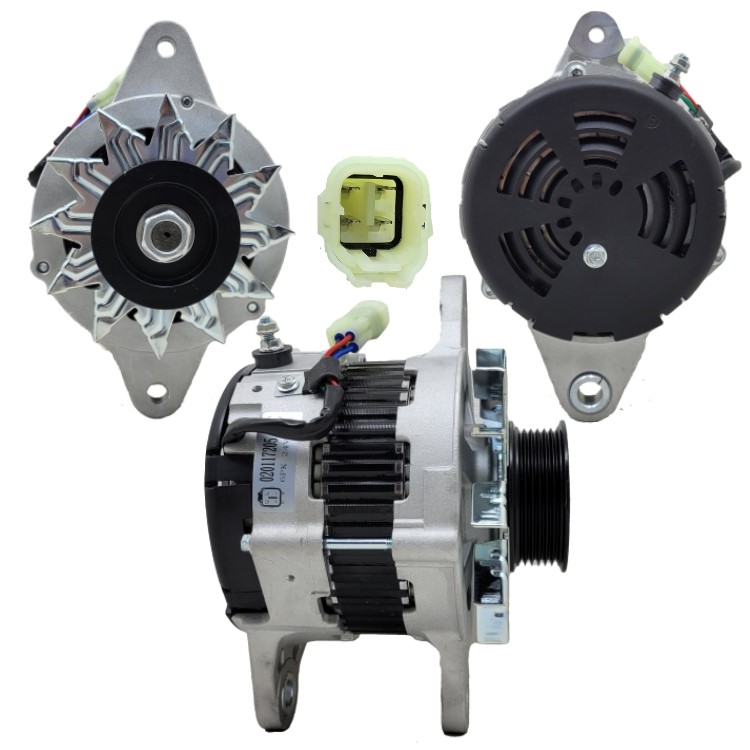
The Technical Challenge of Combining OEM and Aftermarket Truck Parts
Modern heavy-duty commercial vehicles represent a highly integrated, sophisticated framework of mechanical, pneumatic, and electronic subsystems that must function as a single, synchronized unit. In the competitive environment of fleet maintenance, sourcing components from a mix of Original Equipment Manufacturer (OEM) and Aftermarket suppliers is often a necessary economic strategy. However, this approach introduces a complex technical imperative: every replacement part must achieve absolute compatibility with the vehicle's original design architecture. A failure to ensure this critical technical match, whether in electronic signaling, geometric tolerance, or pressure control, risks not only premature component failure but a systemic breakdown that compromises safety, vehicle performance, and operational uptime.
The successful integration of mixed components hinges on a supplier's deep technical knowledge of how seemingly disparate parts, which are from a high-tolerance transmission to a simple solenoid, interact at the system level. Procurement must move beyond simple cost comparison to a rigorous validation of technical fit, form, and function to preserve the vehicle’s overall integrity.
The Challenge of Electronic Interoperability
Electronic systems constitute the nervous center of a modern truck, managing critical functions from engine operation to braking modulation via a complex digital network. When sourcing electric & electrical parts from Aftermarket channels, the greatest challenge is ensuring perfect electronic interoperability, as even minor deviations can corrupt the entire digital communication flow.
Navigating Digital Protocols and Sensor Accuracy

The vehicle's control modules rely on precise data protocols, such as the Controller Area Network (CAN Bus), for real-time communication. Any component connected to this network, whether a complex Engine Control Unit (ECU) or a peripheral sensor, must adhere exactly to the OEM’s defined electronic specifications.
- Signal Conformity: The output of an Aftermarket sensor, often integrated into parts like brake valves or suspension linkages, must match the OEM’s exact voltage and frequency specifications. An inconsistent signal can be misinterpreted by the ECU, leading to the deployment of default operating parameters (e.g., "limp mode") or the generation of persistent, hard-to-diagnose fault codes.
- E-Vehicle Components and Power Demand: With the increasing adoption of E-vehicle parts and sophisticated subsystems, the demand for clean, stable power is paramount. Aftermarket alternators, voltage regulators, and associated wiring harnesses (air & electric coils) must deliver superior power quality to protect sensitive processors from voltage spikes or drops. A compromise in power filtering can lead to erratic behavior in actuators and expensive damage to control modules.
- Load Resistance in Accessory Systems: Simple components, such as light & bulbs and their associated harnesses, possess a specific electrical load resistance. Modern trucks use this resistance to verify circuit integrity. If an Aftermarket component presents an incorrect load, the Body Control Module (BCM) may incorrectly register a fault, leading to intermittent functionality or requiring the use of supplementary hardware kits and extensive reprogramming to clear the error.
- Actuator Synchronization: High-precision components like solenoids and proportional valves in air management or engine turbocharging must respond to electrical impulses with exact timing and duration. A poorly specified Aftermarket solenoid may open too slowly or too quickly, resulting in poor performance, excessive wear on linked engine parts, or destabilization of the entire system.
Maintaining Pneumatic and Safety Precision
The air system is fundamentally critical to safety and represents the truck's primary mechanism for functional control, governing air breaks, auxiliary systems, and air springs. Integrity in this area requires absolute mechanical and pneumatic precision, as compromised pressure or leaks directly affect stopping power and stability.
Air Quality, Pressure Consistency, and Brake Synchronization
The pneumatic network is vulnerable to contamination and pressure inconsistency, issues that often originate with non-compliant Aftermarket components.
- Air Quality Management: The air dryer plays a non-negotiable role in removing moisture and contaminants from the system. If an Aftermarket air dryer utilizes media that is not chemically equivalent to the OEM specification, it may fail to adequately protect high-precision components like control valves and brake chambers. Moisture ingress leads to internal corrosion, freezing in cold climates, and the rapid degradation of internal diaphragm & seals.
- Brake Chamber and Valve Calibration: The final components in the air brake chain, the brake chambers and associated brake valves, require internal calibration that is verified to the manufacturer's standards. Inconsistent internal springing or diaphragm stiffness in a replacement brake chamber can cause non-uniform braking pressure across the axles, destabilizing the vehicle under heavy braking.
- Automatic Slack Adjuster Integration: Slack adjusters automatically maintain the correct clearance between the brake shoes, linings & kits and the brake drums. If an Aftermarket brake component alters the geometry of the lever arm or the camshafts within the assembly, the automatic slack adjusters can over or under-adjust, leading to either excessive pedal travel or dangerous brake drag.
- ABS and Pressure Modulation: The anti-lock braking system (ABS breaks) requires rapid and accurate pressure adjustments to individual wheels, a function executed by the control valves. The responsiveness and sealing of these valves, as well as the integrity of the diaphragm & seals, are paramount. A sluggish Aftermarket valve will compromise the ABS breaks’ ability to modulate pressure effectively, extending stopping distances and increasing skidding risk.
- Suspension Leveling: Air springs must be perfectly synchronized with their leveling control valves. Any pressure bleed or inconsistency in the air springs can throw off the ride height, placing undue stress on suspension parts and, critically, altering the vehicle's center of gravity and aerodynamic profile.
The Need for Mechanical Alignment
Mechanical parts, including axles, transmissions, and engine parts, present a physical challenge: they must align perfectly and withstand immense kinematic stress without inducing destructive vibrations. When combining OEM and Aftermarket mechanical components, the emphasis shifts to geometric accuracy, material quality, and rotational balance.
Critical Positioning of the Drivetrain and Chassis
Precision in the drivetrain is measured not in millimeters, but in the tolerance for vibration, which dictates the lifespan of nearly every rotating component.
- Drivetrain Balance and Vibration Mitigation: High-speed rotational components—including u-joints, center supports, and shafts within the transmissions—must match the OEM's mass and balance specifications precisely. A component imbalance, particularly in a u-joint or axle assembly, introduces harmonic vibration that propagates through the vehicle's framework. This sustained vibration accelerates wear on seals and bearings throughout the transmission and differential, leading to catastrophic failure far sooner than expected.
- Brake System Geometry: Brake calipers & kits and associated brake discs demand extremely tight manufacturing tolerances. If an Aftermarket caliper body is geometrically non-compliant, it can cause uneven clamping force, leading to premature and uneven wear on brake shoes, linings & kits, thermal fatigue in the brake discs, and reduced braking effectiveness. Similarly, brake drums must maintain perfect concentricity to prevent judder and uneven application.
- Engine Part Precision: Components within the engine, such as camshafts and other complex engine parts, operate under intense thermal and mechanical stress. Aftermarket parts must not only match geometric specifications but also use materials (e.g., specific metal alloys) that offer identical thermal expansion and wear characteristics to prevent rapid degradation and potential engine failure.
- Structural and Exterior Fitment: Even components like body parts, doors, and mirrors require accurate dimensional compliance. Poorly fitting exterior parts increase aerodynamic drag, negatively impacting fuel economy. More importantly, incorrect geometry in structural components can compromise crash safety standards and introduce unwanted stress points into the chassis, often requiring fleet technicians to use excessive force or modify the vehicle's structure during installation, requiring additional hardware kits and labor.
- Suspension and Steering Geometry: Every suspension part contributes to the vehicle’s steering and handling geometry. Non-compliant control arms or linkages can change the caster, camber, and toe angles, leading to rapid, uneven wear on tires and potential handling instability. The correct fitment of the fifth wheel assembly is also critical, as it determines the dynamic load transfer and stability of the tractor-trailer combination.
All Truck Parts: Your Strategic Partner for System Integrity
Navigating the complexities of mixed component sourcing such as balancing cost-effectiveness with the need for absolute technical compatibility, requires specialized product knowledge. All Truck Parts serves as the essential strategic partner, bridging the supply chain quality gap.
All Truck Parts understands that the long-term cost of an unreliable part far outweighs any initial savings. The company’s focus is on validating that both OEM and high-quality Aftermarket components integrate seamlessly with the existing vehicle framework. By specializing in a comprehensive inventory that includes high-precision items like transmissions and engine parts, where OEM standards are non-negotiable, alongside certified replacement parts such as filters, wipers, and motor oils, All Truck Parts provides fleet managers with a vetted, risk-mitigated procurement strategy. This dedication to technical fitment allows fleets to confidently maximize operational uptime and secure long-term component value.
Conclusion
The operational lifespan and safety of a commercial vehicle are entirely dependent on the perfect synchronization of its components. The technical challenge of integrating mixed OEM and Aftermarket parts demands a rigorous, system-level focus on compatibility across the electronic, pneumatic, and mechanical frameworks. This requires a strategic shift in procurement toward guaranteeing that a replacement component, whether it is a highly stressed u-joint in the drivetrain or a high-response brake valve in the air system, will perform its function without introducing system instability or accelerating the failure of linked parts. By choosing a component supplier that validates this critical technical harmonization across its entire inventory, commercial fleets can maintain system integrity, minimize downtime, and achieve sustainable operational excellence.




